Etymology
The name is originally from Greek δελφίς (delphís), "dolphin",[1] which was related to the Greek δελφύς (delphus), "womb".[2] The animal's name can therefore be interpreted as meaning "a 'fish' with a womb".[3] The name was transmitted via the Latin delphinus[4] (the romanization of the later Greek δελφῖνος – delphinos[5]), which in Medieval Latin became dolfinus and in Old French daulphin, which reintroduced the ph into the word. The term mereswine (that is, "sea pig") has also historically been used.[6]The term 'dolphin' can be used to refer to, under the suborder Odontoceti, all the species in the family Delphinidae (marine dolphins including orcas and pilot whales) and the river dolphin families Iniidae (South American river dolphins), Pontoporiidae (La Plata dolphin), Lipotidae (Yangtze river dolphin) and Platanistidae (Ganges river dolphin and Indus river dolphin).[7][8] This term has often been misused in the US, mainly in the fishing industry, where all small cetaceans (dolphins and porpoises) are considered porpoises, while the fish dorado is called dolphin fish.[9] In common usage the term 'whale' is used only for the larger cetacean species,[10] while the smaller ones with a beaked or longer nose are considered 'dolphins'.[11] The name 'dolphin' is used casually as a synonym for bottlenose dolphin, the most common and familiar species of dolphin.[12] Killer whales also belong to the family Delphinidae and therefore qualify as dolphins. Though the terms 'dolphin' and 'porpoise' are sometimes used interchangeably, porpoises are not considered dolphins and have different physical features such as a shorter beak and spade-shaped teeth; they also differ in their behavior. Porpoises belong to the family Phocoenidae and share a common ancestry with the Delphinidae.[12]
A group of dolphins is called a "school" or a "pod". Male dolphins are called "bulls", females "cows" and young dolphins are called "calves".[13]
Taxonomy
- Suborder Odontoceti, toothed whales
- Family Delphinidae, oceanic dolphins
- Genus Delphinus
- Long-beaked common dolphin, Delphinus capensis
- Short-beaked common dolphin, Delphinus delphis
- Genus Tursiops
- Common bottlenose dolphin, Tursiops truncatus
- Indo-Pacific bottlenose dolphin, Tursiops aduncus
- Burrunan dolphin, Tursiops australis, a newly discovered species from the sea around Melbourne in September 2011.[14]
- Genus Lissodelphis
- Northern right whale dolphin, Lissodelphis borealis
- Southern right whale dolphin, Lissodelphis peronii
- Genus Sotalia
- Genus Sousa
- Indo-Pacific humpback dolphin, Sousa chinensis
- Chinese white dolphin (the Chinese variant), Sousa chinensis chinensis
- Atlantic humpback dolphin, Sousa teuszii
- Indo-Pacific humpback dolphin, Sousa chinensis
- Genus Stenella
- Atlantic spotted dolphin, Stenella frontalis
- Clymene dolphin, Stenella clymene
- Pantropical spotted dolphin, Stenella attenuata
- Spinner dolphin, Stenella longirostris
- Striped dolphin, Stenella coeruleoalba
- Genus Steno
- Rough-toothed dolphin, Steno bredanensis
- Genus Cephalorhynchus
- Chilean dolphin, Cephalorhynchus eutropia
- Commerson's dolphin, Cephalorhynchus commersonii
- Heaviside's dolphin, Cephalorhynchus heavisidii
- Hector's dolphin, Cephalorhynchus hectori
- Genus Grampus
- Risso's dolphin, Grampus griseus
- Genus Lagenodelphis
- Fraser's dolphin, Lagenodelphis hosei
- Genus Lagenorhynchus
- Atlantic white-sided dolphin, Lagenorhynchus acutus
- Dusky dolphin, Lagenorhynchus obscurus
- Hourglass dolphin, Lagenorhynchus cruciger
- Pacific white-sided dolphin, Lagenorhynchus obliquidens
- Peale's dolphin, Lagenorhynchus australis
- White-beaked dolphin, Lagenorhynchus albirostris
- Genus Orcaella
- Australian snubfin dolphin, Orcaella heinsohni
- Irrawaddy dolphin, Orcaella brevirostris
- Genus Peponocephala
- Melon-headed whale, Peponocephala electra
- Genus Orcinus
- Killer whale (Orca), Orcinus orca
- Genus Feresa
- Pygmy killer whale, Feresa attenuata
- Genus Pseudorca
- False killer whale, Pseudorca crassidens
- Genus Globicephala
- Long-finned pilot whale, Globicephala melas
- Short-finned pilot whale, Globicephala macrorhynchus
- Genus †Australodelphis
- Genus Delphinus
- Family Platanistidae
- Ganges and Indus river dolphin, Platanista gangetica with two subspecies
- Ganges river dolphin (or Susu), Platanista gangetica gangetica
- Indus river dolphin (or Bhulan), Platanista gangetica minor
- Ganges and Indus river dolphin, Platanista gangetica with two subspecies
- Family Iniidae
- Amazon river dolphin (or Boto), Inia geoffrensis
- Orinoco river dolphin (the Orinoco subspecies), Inia geoffrensis humboldtiana
- Araguaian river dolphin (Araguaian boto), Inia Araguaiaensis
- Bolivian river dolphin, Inia boliviensis
- Amazon river dolphin (or Boto), Inia geoffrensis
- Family Lipotidae
- Baiji (or Chinese river dolphin), Lipotes vexillifer (possibly extinct, since December 2006)
- Family Pontoporiidae
- La Plata dolphin (or Franciscana), Pontoporia blainvillei
- Family Delphinidae, oceanic dolphins
- Melon-headed whale, Peponocephala electra
- Killer whale (Orca), Orcinus orca
- Pygmy killer whale, Feresa attenuata
- False killer whale, Pseudorca crassidens
- Long-finned pilot whale, Globicephala melas
- Short-finned pilot whale, Globicephala macrorhynchus
Hybridization
In 1933, three strange dolphins beached off the Irish coast; they appeared to be hybrids between Risso's and bottlenose dolphins.[15] This mating was later repeated in captivity, producing a hybrid calf. In captivity, a bottlenose and a rough-toothed dolphin produced hybrid offspring.[16] A common-bottlenose hybrid lives at SeaWorld California.[17] Other dolphin hybrids live in captivity around the world or have been reported in the wild, such as a bottlenose-Atlantic spotted hybrid.[18] The best known hybrid is the wolphin, a false killer whale-bottlenose dolphin hybrid. The wolphin is a fertile hybrid. Two wolphins currently live at the Sea Life Park in Hawaii; the first was born in 1985 from a male false killer whale and a female bottlenose. Wolphins have also been observed in the wild.[19]Evolution and anatomy

Evolution
See also: Evolution of cetaceans
Along with whales and porpoises, dolphins are descendants of terrestrial mammals, most likely of the Artiodactyl order. The ancestors of the modern-day dolphins entered the water roughly 55 million years ago, in the Eocene epoch.[20]Anatomy

Dolphins have a streamlined fusiform body, adapted for fast swimming. The tail fin, called the fluke, is used for propulsion while the pectoral fins, together with the entire tail section, provide directional control. The dorsal fin, in those species that have one, provides stability while swimming. Though varying by species, basic coloration patterns are shades of grey, usually with a lighter underside and often with lines and patches of different hue and contrast.
The head contains the melon, a round organ used for echolocation. In many species, elongated jaws form a distinct beak; species such as the bottlenose have a curved mouth which looks like a fixed smile. Some species have up to 250 teeth. Dolphins breathe through a blowhole on top of their head. The trachea is anterior to the brain. The dolphin brain is large and highly complex, and is different in structure from that of most land mammals.[22]
Unlike most mammals, dolphins do not have hair, except for a few hairs around the tip of their rostrum (beak) which they lose shortly before or after birth.[23] The only exception to this is the Boto river dolphin, which has persistent small hairs on the rostrum.[24]
Dolphins' reproductive organs are located on the underside of the body. Males have two slits, one concealing the penis and one further behind for the anus.[25] The female has one genital slit, housing the vagina and the anus. Two mammary slits are positioned on either side of the female's genital slit.[26][27][28]
Dolphins can tolerate and recover from extreme injuries such as shark bites although the exact methods used to achieve this are not known. The healing process is rapid and even very deep wounds do not cause dolphins to hemorrhage to death. Furthermore, even gaping wounds restore in such a way that the animal's body shape is restored, and infection of such large wounds seems rare.[29]
A study at the U.S. National Marine Mammal Foundation revealed that dolphins, like humans, develop a natural form of type 2 diabetes which may lead to a better understanding of the disease and new treatments for both humans and dolphins.[30]
Senses

Most dolphins have acute eyesight, both in and out of the water, and they can hear frequencies ten times or more above the upper limit of adult human hearing.[31] Though they have a small ear opening on each side of their head, it is believed hearing underwater is also, if not exclusively, done with the lower jaw, which conducts sound to the middle ear via a fat-filled cavity in the lower jaw bone. Hearing is also used for echolocation, which all dolphins have. Dolphin teeth are believed to function as antennae to receive incoming sound and to pinpoint the exact location of an object.[32] Beyond locating an object, echolocation also provides the animal with an idea on the object's shape and size, though how exactly this works is not yet understood.[33] The Indus Dolphin is effectively blind. This may be because not much light penetrates the waters of the Indus river (due to suspended sediments), making the need for vision unnecessary.[34]
The dolphin's sense of touch is also well-developed, with free nerve endings densely packed in the skin, especially around the snout, pectoral fins and genital area. However, dolphins lack an olfactory nerve and lobes, and thus are believed to have no sense of smell.[35] They do have a sense of taste and show preferences for certain kinds of fish. Since dolphins spend most of their time below the surface, tasting the water could function like smelling, in that substances in the water can signal the presence of objects that are not in the dolphin’s mouth.
Though most dolphins do not have hair, they do have hair follicles that may perform some sensory function.[36] The small hairs on the rostrum of the Boto river dolphin are believed to function as a tactile sense possibly to compensate for the Boto's poor eyesight.[37]
Behavior
See also: Whale surfacing behaviour
Dolphins are often regarded as one of Earth's most intelligent
animals, though it is hard to say just how intelligent. Comparing
species' relative intelligence is complicated by differences in sensory
apparatus, response modes, and nature of cognition. Furthermore, the
difficulty and expense of experimental work with large aquatic animals
has so far prevented some tests and limited sample size and rigor in
others. Compared to many other species, however, dolphin behavior has
been studied extensively, both in captivity and in the wild. See cetacean intelligence for more details.Social behavior
Dolphins communicate using a variety of clicks, whistle-like sounds and other vocalizations. Dolphins also use nonverbal communication by means of touch and posturing.[42]
Dolphins also display culture, something long believed to be unique to humans (and possibly other primate species). In May 2005, a discovery in Australia found Indo-Pacific bottlenose dolphins (Tursiops aduncus) teaching their young to use tools. They cover their snouts with sponges to protect them while foraging. This knowledge is mostly transferred by mothers to daughters, unlike simian primates, where knowledge is generally passed on to both sexes. Using sponges as mouth protection is a learned behavior.[43] Another learned behavior was discovered among river dolphins in Brazil, where some male dolphins use weeds and sticks as part of a sexual display.[44]
Forms of care-giving between fellows and even to different species[45] (see Moko (dolphin)) are recorded in various species such as trying to save weaken fellows[46] to female Pilot Whales holding dead-calf for long periods.
Dolphins engage in acts of aggression towards each other. The older a male dolphin is, the more likely his body is to be covered with bite scars. Male dolphins engage in acts of aggression apparently for the same reasons as humans: disputes between companions and competition for females. Acts of aggression can become so intense that targeted dolphins sometimes go into exile after losing a fight.
Male bottlenose dolphins have been known to engage in infanticide. Dolphins have also been known to kill porpoises for reasons which are not fully understood, as porpoises generally do not share the same diet as dolphins and are therefore not competitors for food supplies.[47]
Reproduction and sexuality
See also: Bottlenose dolphin § Reproduction, Dusky dolphin § Social behavior and reproduction and Short-beaked common dolphin § Reproduction
Dolphin copulation happens belly to belly; though many species engage in lengthy foreplay, the actual act is usually brief, but may be repeated several times within a short timespan.[48] The gestation period varies with species; for the small Tucuxi dolphin, this period is around 11 to 12 months,[49] while for the orca, the gestation period is around 17 months.[50] Typically dolphins give birth to a single calf, which is, unlike most other mammals, born tail first in most cases.[51] They usually become sexually active at a young age, even before reaching sexual maturity.[48] The age of sexual maturity varies by species and gender.[52]Dolphins are known to display non-reproductive sexual behavior, engaging in masturbation, stimulation of the genital area of other individuals using the rostrum or flippers, and homosexual contact.[48][53][54] Various species of dolphin have been known to engage in sexual behavior up to and including copulation with dolphins of other species. Sexual encounters may be violent, with male dolphins sometimes showing aggressive behavior towards both females and other males.[55] Male dolphins may also work together and attempt to herd females in estrus, keeping the females by their side by means of both physical aggression and intimidation, to increase their chances of reproductive success.[56] Occasionally, dolphins behave sexually towards other animals, including humans.[57]
Feeding
Various methods of feeding exist among and within species, some apparently exclusive to a single population. Fish and squid are the main food, but the false killer whale and the orca also feed on other marine mammals. Orcas on occasion also hunt whale species larger than themselves.[58]One common feeding method is herding, where a pod squeezes a school of fish into a small volume, known as a bait ball. Individual members then take turns plowing through the ball, feeding on the stunned fish.[58] Coralling is a method where dolphins chase fish into shallow water to catch them more easily.[58] Orcas and bottlenose dolphins have also been known to drive their prey onto a beach to feed on it, a behaviour known as beach or strand feeding.[59][60] Some species also whack fish with their flukes, stunning them and sometimes knocking them out of the water.[58]
Reports of cooperative human-dolphin fishing date back to the ancient Roman author and natural philosopher Pliny the Elder.[61] A modern human-dolphin partnership currently operates in Laguna, Santa Catarina, Brazil. Here, dolphins drive fish towards fishermen waiting along the shore and signal the men to cast their nets. The dolphins’ reward is the fish that escape the nets.[62][63]
Vocalizations

Bottlenose dolphins have been found to have signature whistles, a whistle that is unique to a specific individual. These whistles are used in order for dolphins to communicate with one another by identifying an individual. It can be seen as the dolphin equivalent of a name for humans.[66] These signature whistles are developed during a dolphin's first year; it continues to maintain the same sound throughout its lifetime.[67] In order to obtain each individual whistle sound, dolphins undergo vocal production learning. This consists of an experience with other dolphins that modifies the signal structure of an existing whistle sound. An auditory experience influences the whistle development of each dolphin. Dolphins are able to communicate to one another by addressing another dolphin through mimicking their whistle. The signature whistle of a male bottlenose dolphin tends to be similar to that of their mother, while the signature whistle of a female bottlenose dolphin tends to be more unique.[68] Bottlenose dolphins have a strong memory when it comes to these signature whistles, as they are able to relate to a signature whistle of an individual they have not encountered for over twenty years.[69] Research done on signature whistle usage by other dolphin species is relatively limited. The research on other species done so far has yielded varied outcomes and inconclusive results.[70][71][72][73]
Because dolphins are generally associated in groups, communication is necessary. Signal masking is when other similar sounds (conspecific sounds) interfere with the original acoustic sound.[74] In larger groups, individual whistle sounds are less prominent. Dolphins tend to travel in pods, upon which there are groups of dolphins that range from a few to many. Although they are traveling in these pods, the dolphins do not necessarily swim right next to each other. Rather, they swim within the same general vicinity. In order to prevent losing one of their pod members, there are higher whistle rates. Because their group members were spread out, this was done in order to continue traveling together.
Jumping and playing
Dolphins frequently leap above the water surface, this being done for various reasons. When travelling, jumping can save the dolphin energy as there is less friction while in the air.[75] This type of travel is known as porpoising.[75] Other reasons include orientation, social displays, fighting, non-verbal communication, entertainment and attempting to dislodge parasites.[76][77]Dolphins show various types of playful behavior, often including objects, self-made bubble rings, other dolphins or other animals.[8][78][79] When playing with objects or small animals, common behavior includes carrying the object or animal along using various parts of the body, passing it along to other members of the group or taking it from another member, or throwing it out of the water.[78] Dolphins have also been observed harassing animals in other ways, for example by dragging birds underwater without showing any intent to eat them.[78] Playful behaviour that involves an other animal species with active participation of the other animal can also be observed however. Playful human interaction with dolphins being the most obvious example, however playful interactions have been observed in the wild with a number of other species as well, such as Humpback Whales and dogs.[80][81]
Sleeping
Further information: Sleep (non-human)
Generally, dolphins sleep with only one brain hemisphere in slow-wave sleep
at a time, thus maintaining enough consciousness to breathe and to
watch for possible predators and other threats. Earlier sleep stages can
occur simultaneously in both hemispheres.[82][83][84]
In captivity, dolphins seemingly enter a fully asleep state where both
eyes are closed and there is no response to mild external stimuli. In
this case, respiration is automatic; a tail kick reflex keeps the blowhole above the water if necessary. Anesthetized dolphins initially show a tail kick reflex.[85] Though a similar state has been observed with wild sperm whales, it is not known if dolphins in the wild reach this state.[86] The Indus river dolphin
has a sleep method that is different from that of other dolphin
species. Living in water with strong currents and potentially dangerous
floating debris, it must swim continuously to avoid injury. As a result,
this species sleeps in very short bursts which last between 4 and
60 seconds.[87]Threats

Natural threats
Except for humans (discussed below), dolphins have few natural enemies. Some species or specific populations have none, making them apex predators. For most of the smaller species of dolphins, only a few of the larger sharks, such as the bull shark, dusky shark, tiger shark and great white shark, are a potential risk, especially for calves.[88] Some of the larger dolphin species, especially orcas (killer whales), may also prey on smaller dolphins, but this seems rare.[89][90] Dolphins also suffer from a wide variety of diseases and parasites.[91][92] The Cetacean morbillivirus in particular has been known to cause regional epizootics often leaving hundreds of animals of various species dead.[93][94] Symptoms of infection are often a severe combination of pneumonia, encephalitis and damage to the immune system, which greatly impair the cetacean's ability to swim and stay afloat unassisted.[95][96]Human threats
See also: Dolphin drive hunting and Cetacean bycatch
Pesticides, heavy metals, plastics, and other industrial and agricultural pollutants that do not disintegrate rapidly in the environment concentrate in predators such as dolphins.[98] Injuries or deaths due to collisions with boats, especially their propellers, are also common.
Various fishing methods, most notably purse seine fishing for tuna and the use of drift and gill nets, unintentionally kill many dolphins.[99] Accidental by-catch in gill nets and incidental captures in antipredator nets that protect marine fish farms are common and pose a risk for mainly local dolphin populations.[100][101] In some parts of the world, such as Taiji in Japan and the Faroe Islands, dolphins are traditionally considered food and are killed in harpoon or drive hunts.[102] Dolphin meat is high in mercury and may thus pose a health danger to humans when consumed.[103]
Dolphin safe labels attempt to reassure consumers that fish and other marine products have been caught in a dolphin-friendly way. The earliest campaigns with "Dolphin safe" labels were initiated in the 1980s as a result of cooperation between marine activists and the major tuna companies, and involved decreasing incidental dolphin kills by up to 50% by changing the type of nets used to catch tuna. The dolphins are netted only while fishermen are in pursuit of smaller tuna. Albacore are not netted this way, making albacore the only truly dolphin-safe tuna.[citation needed]
Loud underwater noises, such as those resulting from naval sonar use, live firing exercises, and certain offshore construction projects such as wind farms, may be harmful to dolphins, increasing stress, damaging hearing, and causing decompression sickness by forcing them to surface too quickly to escape the noise.[104][105]
Conservation
Organizations such as the Mote Marine Laboratory rescue and rehabilitate sick, wounded, stranded or orphaned dolphins while others, such as the Whale and Dolphin Conservation Society and Hong Kong Dolphin Conservation Society, work on dolphin conservation and welfare. India has declared the dolphin as its national aquatic animal in an attempt to protect the endangered Ganges River Dolphin. The Vikramshila Gangetic Dolphin Sanctuary has been created in the Ganges river for the protection of the animals.Several scientists who have researched dolphin behaviour have proposed that dolphins' unusually high intelligence in comparison to other animals means that dolphins should be seen as non-human persons who should have their own specific rights and that it is morally unacceptable to keep them captive for entertainment purposes or to kill them either intentionally for consumption or unintentionally as by-catch.[106] [107] Four countries – Chile, Costa Rica, Hungary, and India – have declared dolphins to be "non-human persons" and have banned the capture and import of live dolphins for entertainment.[108][109]
Relationships with humans
Mythology
See also: Dolphins in mythology
Dolphins have long played a role in human culture. Dolphins are common in Greek mythology, and many coins from ancient Greece have been found which feature a man, a boy or a deity riding on the back of a dolphin.[110] The Ancient Greeks welcomed dolphins; spotting dolphins riding in a ship’s wake was considered a good omen.[111] In both ancient and later art, Cupid is often shown riding a dolphin.In Hindu mythology, the Ganges River Dolphin is associated with Ganga, the deity of the Ganges river.
Heraldry
Dolphins are sometimes used as symbols, for instance in heraldry. When heraldry developed in the Middle Ages, not much was known about the biology of the dolphin and it was often depicted as a sort of fish. Traditionally, the stylised dolphins in heraldry still may take after this notion, sometimes showing the dolphin skin covered with fish scales.Dolphins are present in the coat of arms of Anguilla and the coat of arms of Romania, and the coat of arms of Barbados has a dolphin supporter. A well-known historical example of a dolphin in heraldry, was the arms for le Dauphin de France, the heir to the throne of France when she was still a kingdom.
Dolphinaria
See also: Dolphinarium
The renewed popularity of dolphins in the 1960s resulted in the appearance of many dolphinaria around the world, making dolphins accessible to the public. Criticism and animal welfare laws forced many to close, although hundreds still exist around the world. In the United States, the best known are the SeaWorld marine mammal parks. In the Middle East the best known are Dolphin Bay at Atlantis, The Palm and the Dubai Dolphinarium.Attacks on humans

Tilikum at SeaWorld. In 2010 he attacked and killed his trainer Dawn Brancheau, in his third fatal incident.
Orcas, the largest species of dolphin, have been involved in fatal attacks on humans in captivity. The record-holder of documented orca fatal attacks, a male named Tilikum that belongs to SeaWorld, has played a role in the death of three people in three different incidents (1991, 1999 and 2010).[113] Tilikum's behaviour sparked the production of the documentary Blackfish, which focuses on the consequences of keeping orcas in captivity. There are documented incidents in the wild, too, but none of them fatal.[114]
Fatal attacks from other species are less common, but there is a registered occurrence off the coast of Brazil in 1994, when a man died after being attacked by a bottlenose dolphin named Tião.[115][116] Tião had suffered harassment by human visitors, including attempts to stick ice cream sticks down his blowhole.[117] Non-fatal incidents occur more frequently, both in the wild and in captivity.
While dolphin attacks occur far less frequently than attacks by other sea animals, such as sharks, some scientists are worried about the careless programs of human-dolphin interaction. Dr. Andrew J. Read, a biologist at the Duke University Marine Laboratory who studies dolphin attacks, points out that dolphins are large and wild predators, so people should be more careful when they interact with them.[112]
Therapy
Dolphins are an increasingly popular choice of animal-assisted therapy for psychological problems and developmental disabilities. For example, a 2005 study found dolphins an effective treatment for mild to moderate depression.[118] However, this study was criticized on several grounds. For example, it is not known whether dolphins are more effective than common pets.[119] Reviews of this and other published dolphin-assisted therapy (DAT) studies have found important methodological flaws and have concluded that there is no compelling scientific evidence that DAT is a legitimate therapy or that it affords more than fleeting mood improvement.[120]Military

See also: Military dolphin
A number of militaries have employed dolphins for various purposes from finding mines to rescuing lost or trapped humans. The military use of dolphins, however, drew scrutiny during the Vietnam War when rumors circulated that the United States Navy was training dolphins to kill Vietnamese divers.[121]
The United States Navy denies that at any point dolphins were trained
for combat. Dolphins are still being trained by the United States Navy
for other tasks as part of the U.S. Navy Marine Mammal Program.
The Russian military is believed to have closed its marine mammal
program in the early 1990s. In 2000 the press reported that dolphins
trained to kill by the Soviet Navy had been sold to Iran.[122]Movies
The 1973 movie The Day of the Dolphin portrays kidnapped dolphins performing a naval military assassination using explosives. This was also explored in the similarly named The Simpsons Treehouse of Horror episode, "Night of the Dolphin", where Lisa frees a dolphin at an aquarium exhibit and unwittingly initiates their plan to overthrow the land-dwellers and live in their place. The 1990s science fiction television series seaQuest DSV featured a bottlenose dolphin named Darwin who could communicate using a vocoder, a fictional invention which translated clicks and whistles to English and back.
The 1995 movie Johnny Mnemonic portrays an ex-military dolphin named Jones who tries to find a password for Johnny by decrypting data in the latter's head.
Killer whales have also been portrayed in film, though to a lesser extent than bottlenose dolphins. The 1977 horror movie Orca portrayed killer whales as intelligent and capable of pair-bonding and aggressive behavior. In the movie, a male killer whale takes revenge on fishermen after they kill his mate. The 1993 movie Free Willy made a star of the killer whale playing Willy, Keiko.
Literature
Dolphins are common in contemporary literature, especially science fiction novels. Biophysicist Leó Szilárd, one of the Manhattan Project scientists who invented the atomic bomb and also urged U.S. presidents not to use it, featured dolphins as a metaphor for voices of reason in a Cold War short story "The Voice of the Dolphin" (1960). In it, Russian and American scientists come together and learn to communicate with dolphins, changing the world.[123] Dolphins play a military role in William Gibson's short story Johnny Mnemonic, in which cyborg dolphins find submarines and decode encrypted information. Dolphins play a role as sentient patrollers of the sea enhanced with a deeper empathy toward humans in Anne McCaffrey's The Dragonriders of Pern series. In the Known Space universe of author Larry Niven, dolphins play a significant role as fully recognised "legal entities". More humorous is Douglas Adams’ The Hitchhiker's Guide to the Galaxy series of picaresque novels, in which dolphins are the second most intelligent creatures on Earth (after mice, followed by humans) and try in vain to warn humans of Earth’s impending destruction. Their story is told in So Long, and Thanks for All the Fish. Intelligent dolphins play an important role in David Brin's Uplift series.Dolphins also appear frequently in non-science fiction literature. In the book The Music of Dolphins by author Karen Hesse, dolphins raise a girl from the age of four until the coast guard eventually discovers her. Fantasy author Ken Grimwood wrote dolphins into his 1995 novel Into the Deep about a marine biologist struggling to crack the code of dolphin intelligence, including chapters written from a dolphin viewpoint.
Art
Dolphins are a popular artistic motif, dating back to ancient times. Examples include the Triton Fountain by Bernini and depictions of dolphins in the ruined Minoan palace at Knossos and on Minoan pottery.Cuisine
Dolphin meat is dense and such a dark shade of red as to appear black. Fat is located in a layer of blubber between the meat and the skin. When dolphin meat is eaten in Japan, it is often cut into thin strips and eaten raw as sashimi, garnished with onion and either horseradish or grated garlic, much as with sashimi of whale or horse meat (basashi). When cooked, dolphin meat is cut into bite-size cubes and then batter-fried or simmered in a miso sauce with vegetables. Cooked dolphin meat has a flavor very similar to beef liver.[126]
- Health concerns
Similar concerns exist with the consumption of dolphin meat in the Faroe Islands, where prenatal exposure to methylmercury and PCBs primarily from the consumption of pilot whale meat has resulted in neuropsychological deficits amongst children.[130]

Common bottlenose dolphin range (in blue)
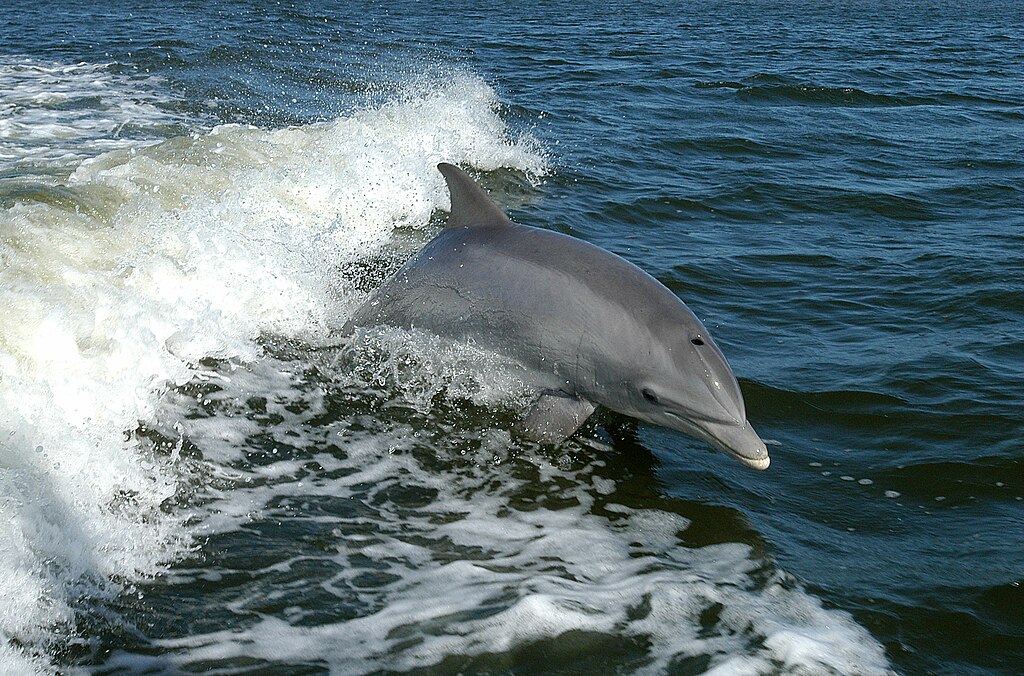
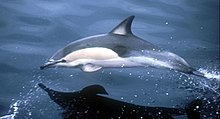


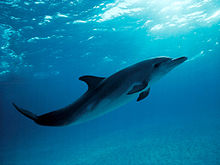




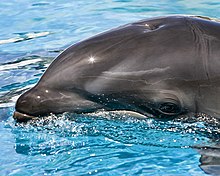




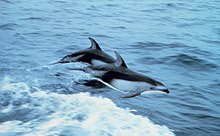

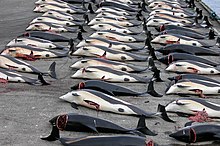





No comments:
Post a Comment
Note: Only a member of this blog may post a comment.